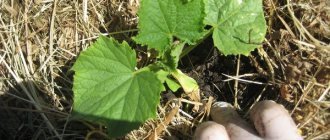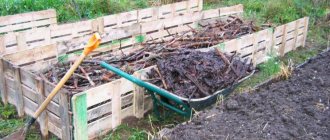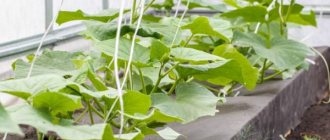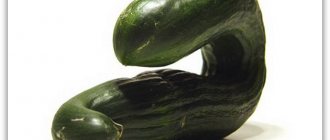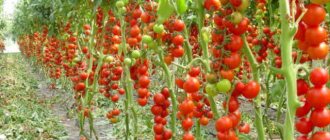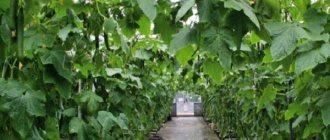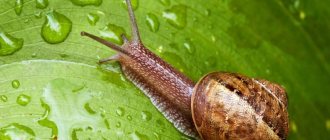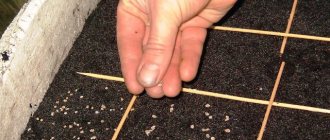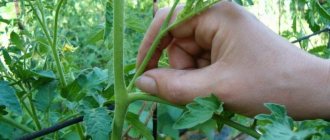The modern chemical industry regularly produces new generation fertilizers.
Each time they contain more and more nutrients, they are safer for plants, and more and more destructive for pathogenic microorganisms and insect pests. But so far, no fertilizer has been able to come close to the effectiveness and availability of ordinary wood ash. This natural product has been used as a fertilizer for thousands of years and still does not lose its relevance. Dear readers!
For you, we have created communities on social networks in which useful articles and interesting ideas are published several times a day! Subscribe and receive useful content in a convenient format! This time we will talk about fertilizing cucumbers in a greenhouse with ash.
How to determine that cucumbers need ash
In general, ash can be applied as a complex fertilizer, which helps the plant develop. But there are external signs by which you can determine that cucumbers need wood or grass ash.
For example, calcium deficiency. It can be identified by its pale leaves and vines. The leaf blades curl inward, and the ovaries and flowers fall off. With a potassium deficiency, greens bend. With a lack of phosphorus, the foliage turns yellow. In all these cases, an ash solution will help.
It also doesn’t hurt to sprinkle dry fertilizer over the garden bed and into the hole when transplanting cucumber seedlings or in case of frequent seedling diseases.
Signs of calcium and potassium deficiency
Ash is used as a fertilizer for cucumbers if the plants show external manifestations of calcium deficiency:
- the leaves turn white;
- the leaf plates are deformed - the edges curl down and the tip bends up;
- necrotic spots appear.
There is less potassium in the composition, but it is enough for the plant to develop well. If the leaves wither but do not fall off the branches, this means it is time to apply potassium mineral fertilizers or ash fertilizers.
Potassium deficiency occurs most often:
- on sandy soils that are not able to retain the element in the soil, it is quickly washed away during watering or rain;
- with a lack of moisture, plants cannot absorb nutrition, even if it is present in the soil;
- on heavy clay soils.
Potassium deficiency is determined by marginal drying of the leaf blade and brown spots on the leaves.
When asked what is better: organic fertilizers or mineral ones, we can assume that organic soil additives are better. After their use, the acidity does not increase, the fertile layer is restored.
The content of soil bacteria increases after adding wood ash as a fertilizer for cucumbers. This affects aeration - the exchange of oxygen in the soil.
What microelements does ash contain that are beneficial for cucumbers?
The most common slag, which can be obtained from burning tree branches and plant tops, is a real storehouse of useful microelements.
In general, the chemical composition of ash is the same when burning grass and burning wood. The main microelements that plants need are phosphorus, potassium and calcium. But depending on what was burned, their proportions change slightly.
For example, burnt sunflowers will produce more potassium and less phosphorus. And burnt birch bark will bring more calcium.
The best choice for cucumbers in a greenhouse is ash from birch bark, straw, as well as slag obtained from the combustion of several types of plant residues at once. But in any case, you can use any ash except that obtained from burning household waste. It contains combustion products of harmful chemicals: varnishes, paints, etc.
REFERENCE. Apart from the above chemicals, ash also contains molybdenum, magnesium, iron, zinc, sulfur, potassium, etc.
The chemical composition of ash and the effect it has on the plant
Ash is an extremely useful organic fertilizer, extremely rich in various chemical elements.
It contains not only potassium and phosphorus, which are essential for garden plants, but also many microelements, only nitrogen and no chlorine, so this natural fertilizer can be used for any crop. It contains a lot of calcium, which is considered the main advantage of using ash powder to feed garden crops with this element.
The chemical composition of ash is not constant, it depends on the type of plants that were burned, as well as their age (there are more useful substances in the ashes of young plants than in the ashes of old ones), but on average it is in the following ratio:
- phosphorus – 16.5%;
- potassium – 17%;
- iron – 13%;
- zinc – 15%;
- boron, sulfur and manganese – 4%;
- calcium – 14%;
- magnesium – 12%;
- molybdenum – 0.5%.
Since there is an unequal amount of chemical elements in ash, it has different effects on plants and soil. For example, ash residue after burning birch branches or wheat straw can be used as phosphorus-potassium fertilizer, ash from burning sunflower stems or buckwheat tops can be used as potassium fertilizer. Ash powder can also be used to reduce soil acidity (what's left from burning coniferous trees or peat is suitable).
Ash for cucumbers is very useful, and above all, for increasing productivity. This is achieved due to the fact that after its use, plant leaves become larger and acquire a rich color, which leads to an increase in photosynthesis processes in them. After fertilizing cucumbers with ash, the number of flowers also increases, many ovaries appear, and the plants themselves become stronger, more resistant to diseases and pest attacks. It is also useful for calcium deficiency, which is manifested by weakness of cucumber roots, pallor of young cucumber leaves and shoot tips, bending of leaf blades down, falling of flowers and young ovaries.
How to properly feed cucumbers with ash in a greenhouse step by step
Step 1. The ash must be collected and sifted thoroughly to obtain flour.
Step 2 . Next, the concentrate is prepared. For 1 liter of water you need 1-2 tablespoons of ash. It is better to use hot water. The mixture is thoroughly mixed and infused for 48 hours.
Step 3. The resulting mixture is used to water the plants.
Alternative way. Dry feeding.
Step 1. Fertilizer is prepared. It is better to use fresh ashes.
Step 2. Ashes are scattered between the beds (up to 100 g per 1 square meter).
Step 3 . Watering is in progress.
ON A NOTE. Dry fertilizing can also be carried out when planting seedlings and autumn soil preparation.
On what soils can ash fertilizer be used?
It is recommended to use ash only on acidic or neutral soil. The fertilizer acts like an alkali, therefore it deoxidizes any soil in a short time. This does not mean at all that ash cannot be used on alkaline soil - it is enough to carry out such replenishment once every few years.
Coal ash is an excellent means of normalizing certain types of soil at the physical level. For example, it is often used to loosen clayey soil and drain swollen soil. Sandy soil is less susceptible to such treatment, so adding ashes to it is simply impractical.
Recipes for feeding cucumbers with ash
In the table below we have collected recipes for feeding cucumbers at various stages.
Table. Feeding with ash: recipes
| Stage of cultural development | Ash quantity | Amount of water |
| Soaking cucumber seeds before planting | 1 tablespoon | 2 liters |
| First pair of true leaves | 10 tablespoons | 5 liters |
| Bloom | 10 tablespoons | 5 liters |
| Fruiting | 3 glasses | 3 liters |
| Prevention to protect against fungi and insects | 3 kg | 10 liters |
Pest protection
When using ash for cucumbers, you can get rid of a number of insects, fungi and infections. The product is used as a preventative against powdery mildew. Ash lye has a healing effect. To prepare it, you need to sift 2/3 of a bucket of ash and dilute with 10 liters of water. Leave to sit in the sun for several days, remembering to stir. After the fatty liquid appears golden in color on the surface, pour it into another bucket. For dilution you will need more water 1:1. To make the solution stick better to parts of the plant, it is recommended to add a little planed laundry soap. Spray the cucumbers at night, and a few days later carry out the procedure again.
Dry ash is used to get rid of aphids, which often attack plants growing in greenhouses. You need to take a small amount of ash, pre-sifted, and place it in a gauze bag. Then shake it over the lashes that were attacked by insects. Treating young cucumber sprouts helps repel slugs from them. In such a situation, the ashes are simply scattered over the surface of the hole around the growing bushes. The procedure is carried out in the evening. To achieve maximum effect, you need to repeat it every other day, do this at least 3 times.
Attention!
It is necessary to treat cucumber lashes from pests on both sides; the back side deserves special attention.
How to feed cucumbers with ash in open ground
Applying fertilizers in open ground is not much different from a greenhouse. The first feeding is carried out when the first pair of true leaves appear. Next - when flowering begins. Then during fruiting. There should be 3-4 feedings in total (no more than 6!). However, their number needs to be reduced if you alternate ash solution and complex mineral fertilizer.
Comparison with other mineral fertilizers
Wood ash makes a good mineral natural fertilizer. Although it has a complex composition, other supplements cannot be ruled out. However, compared to synthetic mineral fertilizers, it has many advantages. One of the important positive qualities is its natural origin, therefore its use does not have a negative impact on the environment. The vegetables themselves do not accumulate chemicals. A large number of components contained in ash powder are in forms that are easily digestible by plants.
The downside is that it lacks nitrogen. However, this drawback is offset by the additional addition of humus or well-ripened compost to the soil.
How to make foliar feeding
Cucumbers really don’t like having their leaves sprayed, so you need to approach foliar feeding wisely. Firstly, it should be carried out as a last resort. Secondly, the spray must be finely dispersed (that is, the water must be practically in the form of steam). Thirdly, the water should be cooled, but not cold. Its temperature should be approximately equal to the ambient temperature.
The working solution is prepared from 3 tablespoons of ash and 3 liters of water. The mixture is boiled for no more than 10 minutes and then filtered.
How to prepare fertilizer
It is important for every gardener to know how to prepare fertilizer from ash, as well as how much and in what quantity it needs to be applied.
See also
Instructions for using the Rescuer product for cucumbers, when to process themRead
It is best used when it is obtained from natural materials: grass, straw, wood, twigs, branches. Dry plants, grass, and wood are burned, collected in special containers, and then used to treat the garden.
If this is a tree, then it is desirable that it be without poisons and paints. Often plastic bottles, bags and other garbage are added to the fire for burning. This cannot be done, since there will no longer be useful substances for cucumbers, they can even be poison for them. It contains heavy metals, dirt and salts. Boards with fungi and mold also cannot be used to make fertilizer.
You need to collect the fertilizer immediately, fresh, so that moisture does not have time to get on it. After all, wet ashes do not bring any benefit to crops. It is collected, placed in clean, dry containers, and then placed in bags that do not allow moisture to pass through. Everything should be tightly closed. Bags with the date and composition of the mixture can be labeled and stored in a cool, dry place. Then it can be diluted in water, or herbal infusions, or used in dry form.
The advantages of such fertilizers
Fertilizing with ash from trees and grass is very useful for cucumbers in a greenhouse.
- Ash is practically harmless to plants. Of course, you need to know when to stop, but in general it is very difficult to overfeed plants with it.
- Burnt slag enhances the positive effect of nitrogen fertilizing when grown on fertile soil.
- Ash acts as an insecticide and fungicide. Of course, the remedy will not cope with severe cases of infection, but in the early stages of the development of the disease, ash will be very useful.
- The product contains many microelements, so it can be considered a complex fertilizer.
- This is an environmentally friendly fertilizer, not a pesticide.
- Availability of fertilizer. It is enough to collect dry grass, old leaves, dry branches from the garden to get an effective and almost harmless fertilizer.
ON A NOTE. Ash from a young tree is much more beneficial than from an old one.
Useful tips
A few useful tips to help optimize work on your site:
- Disease-affected branches and green plants are not suitable for compost. But they are great for producing ash, which can then be used as fertilizer.
- In order for the ashes to retain their nutritional properties , they must be collected immediately after the fire has cooled and placed in sealed bags. The shelf life in a darkened room at a relative humidity of no higher than 50% is about 2 years. The air temperature during ash storage should not be lower than 0°C.
- Ash can be added to compost. It neutralizes organic acids formed during the overheating of sawdust, peat, and pine needles.
What to do if the cucumbers are overfed?
In general, it is quite difficult to overfeed with ash. To do this, you literally need to add it in bags. So if signs of illness appear, you need to look for the cause in something else. For example, in poor soil or lack of other microelements.
If you are absolutely sure that the problem is ash, then you need to stop feeding, water the cucumbers with clean water without impurities and loosen the soil. If the bushes have not returned to normal within a few days, you can carefully spray them with a weak solution of ammonia.
Preparation of ash
Before fertilizing cucumbers with ash, you need to prepare it. It is best to use the ashes obtained after burning for feeding:
Treatment of cucumbers with brilliant green and iodine: subtleties of feeding, processing and fertilizer. How and why to treat cucumbers with brilliant green (100 photos and videos)
Planting cucumbers in a greenhouse with seeds - 85 photos and video instructions for proper planting of cucumbers
How to form cucumbers - 120 photo descriptions of diagrams and video tips for forming cucumbers with your own hands
- Wood;
- Grasses (hay);
- Straw;
- Vetok.
It is important that the wood is not impregnated with any poison (for example, mastic, antiseptic), is not painted, and does not have mold or mildew on it.
If the ash is intended to be stored until further use, then after cooling it must be collected in a waterproof bag or tightly closed container. The ingress of moisture deteriorates the quality of the fertilizer, destroys beneficial microelements, and makes it unusable.
It is best to use wet fertilizer immediately after preparation. You can spray daily. This promotes the healing of small wounds and increases plant immunity.
Fertilizing cucumbers with ash is an important undertaking. If carried out correctly, it will not harm developing plants and will strengthen their immunity. This will allow you to get a bountiful harvest.
Common mistakes
No one is immune from mistakes. Even an experienced summer resident can make a mistake. Let's look at the most common mistakes associated with feeding cucumbers in a greenhouse with ash.
- Adding ash after liming the soil. This mistake leads to a decrease in harvest volumes and a deterioration in the taste of greens.
- Mixing ash and manure. As a result, the elements neutralize each other, and feeding turns out to be pointless.
- Incorrect dosage. A classic mistake of a novice gardener who believes that the more active ingredient there is, the more effective the fertilizing will be.
- Mixing ash with complex mineral fertilizers. This leads to an excess of microelements. You need to choose one thing, complex fertilizers or ash.
- Adding dry ash to fertile soil. If you have good soil in the greenhouse, then fertilize with ash 1-2 times per season. Microelements that are in the ashes will destroy the balance in the soil.
- Using ash from household waste. This is a grave mistake. The combustion products of household waste contain substances that are poisonous to cucumbers. Even if the plants do not die, it will not be possible to eat greens as they will accumulate nitrates.
Tips from Mister Summer Resident
Feeding cucumbers with ash is very useful for normal growth and development of plantings. It promotes the formation of ovaries and a good harvest. But in order for the effectiveness of its use to be maximum, it is necessary to follow several useful tips from experienced gardeners.
- After dry ash is added to the soil, it must be watered moderately right away so that the nutrients reach the roots.
- Use the ash to prepare a solution in which you can soak the seeds before planting to increase their viability. To do this, 20 g of ash is dissolved in a glass of water, the resulting concentrate is infused for at least 24 hours, after which the seeds are placed in it for 4-5 hours.
- It is better to feed cucumbers with ash more often, but less. Plantings absorb nutrients gradually and little by little, so one dose of fertilizer can be spread over 1-2 days.
- During the period of fruit formation, it is advisable to reduce the amount of fertilizer applied to the soil so that excess elements that can distort the taste do not end up in future cucumbers.
Answers to frequently asked questions
What kind of ash can be used?
Anything obtained from burning trees and their parts and grass. Do not use slag from household waste.
What is the benefit of such fertilizer?
The slag from combustion products contains many microelements necessary for the plant. Moreover, all these microelements are presented in an easily digestible form.
How to properly feed cucumbers in a greenhouse?
You can pour ash water under the root, or you can scatter the ashes and only then pour water on it. You can also use foliar feeding.
What can replace ash?
In general, it is ash that replaces most complex mineral fertilizers. If for some reason you are not tempted by the use of ashes, then buy a complex fertilizer for cucumbers.
When is the best time to apply fertilizer?
At any time, from pre-planting preparation of seeds to the appearance of the first green plants.
When is it not necessary to use this fertilizer?
If you have fertile soils and the harvests are abundant, then fertilizing with an ash solution should be reduced to a minimum or completely abandoned. An excess of microelements in the soil is also harmful to plants.
How to prepare the solution
Cucumbers need liquid ash fertilizers during their active flowering and fruiting . To prepare the solution, take 100-150 sifted ash and dissolve it in a bucket of water. Watering rate: 0.5 liters of solution per adult plant.
Attention! To water with ash, use warm water. After watering with cold water, cucumbers may develop fungal diseases due to hypothermia of the roots.
How to prepare fertilizer for future use
It happens that too much ash is produced (for example, when burning branches left after autumn pruning of an orchard). It won’t be used for the remaining season, and it’s irrational to throw away good raw materials. To harvest for future use, you will need a dry room (outbuilding, barn, greenhouse dressing room) and storage containers (boxes, thick plastic bags).
Ash is only afraid of dampness . It does not lose its valuable properties over time and, if stored correctly, will last for more than one season.
How to breed and apply
It is necessary to prepare a solution from ash for cucumbers, taking into account the proportions, which vary depending on the purpose of the procedure. Here we are talking about:
- seed preparation;
- applying fertilizer at all stages of flowering;
- protection of crops from parasites.
Basically, to apply ash under cucumbers, gardeners prepare a solution from it: 300 g of ash must be dissolved in 10 liters of water.
Attention! The temperature of the liquid should be 40 degrees.
A solution prepared in this way will help treat 1 square meter of soil.
Wood ash as a fertilizer for cucumbers can be used in different ways. The main condition is to apply it correctly, following all the recommendations of experienced vegetable growers. Otherwise, you can add too many chemical elements to the soil, which is also detrimental to the plant, as is their lack.
You can feed cucumbers with wood ash at the following stage:
- preparation of seed material;
- glaze;
- foliar feeding (spraying);
- autumn digging of the garden - dry ashes are used.
In addition, dry ash for cucumbers has shown its effectiveness before watering. Ashes should be sprinkled on the ground under the vegetable and watered well. In this case, the root system receives the necessary nutrients. In the same way, ash is used for cucumbers in a greenhouse.
Processing cucumber seeds
In order for the seed material to sprout faster, vegetable growers use a special solution: dilute 1 tablespoon in two liters of water. spoon of ash. Mix the ingredients thoroughly and leave for 48 hours. Strain the mixture before use.
Seeds must be soaked for 5 hours before planting. The procedure will help to obtain early healthy shoots.
Filling the soil
Vegetable growers can prepare the soil at different times in any way:
- Feed in the fall. To do this, you need to add 2 cups of ash per 1 square meter. Dig up the soil.
- When planting cucumbers or seeds, add ash at the rate of 1-2 cups per 1 square meter;
- Before planting seedlings, sprinkle 2 tablespoons into each hole. ashes.
The procedure will saturate the soil with useful minerals.
You may be interested in:
When and with what fertilizers to feed cucumbers in a greenhouse for a large harvest Growing cucumbers in greenhouse conditions and open areas is not much different, but some nuances still...Read more...
Watering
Watering the plant with ash fertilizer is allowed at all stages of development.
Attention!
The amount of fertilizing during the flowering period depends on the condition of the cucumber vines.
The solution must be diluted as follows:
- dilute ash in 5 liters of water to feed cucumbers (5 tbsp);
- leave the mixture for 7 days, stirring occasionally;
- Strain before using.
It is better to water the seedlings at the root at the rate of 500 ml of product per 2 square meters, when 2 true leaves appear on it. If necessary, the treatment can be repeated, but not earlier than after 7 days.
Foliar sprays
Foliar feeding of cucumbers is most effective at the stage of active fruiting. To dilute the solution, mix the ashes with water and bring to a boil. Boil for 30 minutes, cool. Before use, strain and dilute with liquid so that the total volume is 10 liters.
You need to spray the foliage every 10 days.
Soil preparation
Cucumbers are one of the most popular vegetable crops, characterized by rapid growth and ripening. However, they have a weak root system and require constant care and feeding.
Getting a decent harvest begins with preparing the soil in the greenhouse. In late autumn, after the harvest is complete, the greenhouse should be cleared of debris and the soil should be dug up. It is mandatory to disinfect all metal or wooden parts, glass or polycarbonate sheets that cover the greenhouse. To do this, prepare a bleach solution. 300 g of lime are diluted in 10 liters of water. The resulting mixture should sit for 3-4 hours. The aqueous part of the solution is used for spraying, and the sediment is used for treating cracks.
Before planting seedlings, the holes are watered with a weak solution of potassium permanganate.
The soil needs to be dug up, after adding 10-12 liters of manure, humus or compost per 1 m² of area. To reduce the acidity of the soil, you need to add 400-500 g of lime per 1 m².
With the arrival of spring, the soil must be dug up again, after adding ammonium nitrate - 20-30 g, potassium sulfate - 20 g and superphosphate - 20-30 g. Fertilizers are applied at least 7-10 days before planting cucumbers.
After thoroughly digging and fertilizing, the soil should be well watered. For greater effect, you can add a little potassium permanganate, 1-3 g per 10-12 liters of water. Then the soil is covered with plastic film, which is removed only before planting the seedlings.
If there is a lag in the development of the plant, it grows poorly, produces little ovary - this is a signal for the gardener that the scheme and composition of fertilizing should be revised. When deciding what to fertilize cucumbers with, you should pay attention to the plant itself, which will always “tell” which element it is missing.
Return to contents
